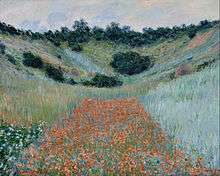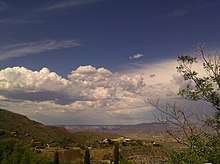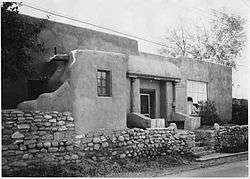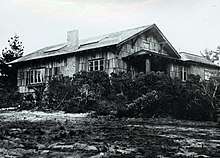Art colony
An art colony, also known as an artists' colony, can be defined two ways. Its most liberal description refers to the organic congregation of artists in towns, villages and rural areas, often drawn by areas natural beauty, the prior existence of other artists or art schools there, and a lower cost of living. More commonly, the term refers to the guest-host model of a mission-driven planned community, which administers a formal process for awarding artist residencies. In the latter case, a typical mission might include providing artists with the time, space and support to create; fostering community among artists; and providing arts education (lectures, workshops) to the public. Early 20th century American guest-host models include New Hampshire's MacDowell Colony and New York's Yaddo.
.jpg)
World-wide, the two primary organizations serving artist colonies and residential centres are Res Artis, in Amsterdam, and the Alliance of Artists Communities, in Providence, Rhode Island.[1] Taiwan's Intra Asia Network is a less formal body working to advance creative communities and exchanges throughout Asia. Collectively, these groups oversee most of the world's active artists' colonies.
Formative period in Europe
_by_Georges_Seurat.jpg)
Art colonies initially emerged as village movements in the 19th and early 20th century. It is estimated that between 1830 and 1914, some 3,000 professional artists participated in a mass movement away from urban centres into the countryside, residing for varying lengths of time in over 80 communities. These colonies are typically characterized according to year-round permanence and population size. Thus, transient colonies had annually fluctuating populations of artists, often painters who visited for just a single summer season, in places, such as Honfleur, Giverny, Katwijk, Frauenchiemsee, Volendam, and Willingshausen. Semi-stable colonies are characterized by their semi-permanent mix of visiting and resident artists who bought or built their own homes and studios. Examples would include Ahrenshoop, Barbizon, Concarneau, Dachau, St. Ives, Laren, and Skagen. Finally, stable colonies are characterized by their large groups of permanent full-time resident artists who bought or built their own homes and studios, in places such as Egmond, Sint-Martens-Latem, Newlyn, and Worpswede.
While artist colonies appeared across Europe, as well as in America and Australia, the majority of colonies were clustered in the Netherlands, Central Germany, and France (encircling Paris).[2] Overall, artists of thirty-five different nationalities were represented throughout these colonies, with Americans, Germans and British forming the largest participating groups.[3] This gave socialising a cosmopolitan flavour: "Russia, Sweden, England, Austria, Germany, France, Australia and the United States were represented at our table, all as one large family, and striving towards the same goal," the painter Annie Goater penned in 1885 in an essay on her recent experiences at one French colony.
Villages can also be classified according to the nationalities they attracted. Barbizon, Pont-Aven, Giverny, Katwijk, Newlyn, and Dachau drew artists from around the world and had a pronounced international flavour. Americans were always a major presence at Rijsoord, Egmond, Grèz-sur-Loing, Laren, and St Ives; Grèz-sur-Loing went through a Scandinavian phase in the 1880s; and Germans were the largest group after the indigenous Dutch at Katwijk. On the other hand, foreigners were rare at Sint-Martens-Latem, Tervuren, Nagybanya, Kronberg, Staithes, Worpswede, and Willingshausen, while Skagen hosted mainly Danes and a few other Scandinavians.[2]

Some painters were renowned within artistic circles for settling down permanently in a single village, most notably Jean-François Millet at Barbizon, Robert Wylie at Pont-Aven, Otto Modersohn at Worpswede, Heinrich Otto at Willinghausen, and Claude Monet at Giverny. They were not necessarily leaders, although these artists were respected and held a certain moral authority in their respective colonies. There were also regular 'colony hoppers' who moved about the art colonies of Europe in a nomadic fashion. Max Liebermann, for instance, painted at Barbizon, Dachau, Etzenhausen and at least six short-lived Dutch colonies; Frederick Judd Waugh worked in Barbizon, Concarneau, Grèz-sur-Loing, St Ives and Provincetown in the United States; Evert Pieters was active at Barbizon, Egmond, Katwijk, Laren, Blaricum, Volendam, and Oosterbeek; Elizabeth Armstrong Forbes painted at Pont-Aven, Zandvoort, Newlyn and St Ives.[2]

The greater number of early European art colonies were to be casualties of the First World War.[3] Europe was no longer the same place socially, politically, economically and culturally, and art colonies seemed a quaint anachronism in an abrasively modernist world. However, a small proportion did endure in one or another form, and owe their continuing existence to cultural tourism. The colonies of Ahrenshoop, Barbizon, Fischerhude, Katwijk, Laren, Sint-Martens-Latem, Skagen, Volendam, Willingshausen, and Worpswede not only still operate in a modest fashion, but run their own museums where, besides maintaining historic collections of work produced at the colony, they organise exhibition and lecture programs. If they have not fared as well, several former major colonies such as Concarneau and Newlyn are remembered via small yet significant collections of pictures held in regional museums. Other colonies succumbed during the late twentieth century to cultural entrepreneurs who have redeveloped villages in the effort to simulate, within certain kitsch parameters, the 'authentic' appearance of the colony during its artistic heyday. This is not always successful, with Giverny, Grèz-sur-Loing, Kronberg, Le Pouldu, Pont-Aven, Schwaan, and Tervuren probably being among the most insensitively commercialised of the former art colonies.[2]
United States
Early Model
Some art colonies are organized and planned, while others arise because some artists like to congregate, finding fellowship and inspiration—and constructive competition—in the company of other artists.
The American Academy in Rome, founded in 1894 originally as the American School of Architecture, which in the following year joined with the American School of Classical Studies, is often cited as the early model for what would become the modern arts and humanities colony.[3] Its well-funded, well-organized campus, and extensive program of fellowships, were soon replicated by early 20th-century artist colonies and their wealthy benefactors.

The Northeast
New Hampshire
The MacDowell Colony in Peterborough was founded in 1907 by composer Edward MacDowell and his wife, Marian. MacDowell was inspired by the American Academy in Rome, and its mission to provide American artists with a home base at the centre of classical traditions and primary sources. MacDowell, who was a trustee of the American Academy, believed that a rural setting, free from distractions, would prove to be creatively valuable to artists. He also believed that discussions among working artists, architects and composers would enrich their work.
New York

Thomas and Wilhelmina Weber Furlong of the Art Students League of New York named their private summer residence the Golden Heart Farm art colony when they opened it in the summer of 1921. Located in upstate New York on Lake George, the colony and its artists in residence were at the center of the American modernist movement as important artists from Manhattan traveled to Golden Heart Farm to escape the city and study with the couple.[4]
Another famous colony, Yaddo in Saratoga Springs was founded soon after. Spencer Trask and his wife Katrina Trask conceived the idea of Yaddo in 1900, but the first residency program for artists did not formally initiate until 1926.
The Woodstock Art Colony in the town of the same name began as two colonies. Originally known as Byrdcliffe, it was founded in 1902 by Ralph Radcliffe Whitehead, Hervey White, and Bolton Brown. Two years later, Hervey White renamed it the Maverick Colony, after seceding from Byrdcliffe in 1904.[5] The town of Woodstock remains an active center of art galleries, music, and theatrical performances.
The Roycroft community was an influential Arts and Crafts art colony that included both artisans and artists. Founded by Elbert Hubbard in 1895, in the village of East Aurora, New York, near Buffalo its artisans were influential on the development of early 20th-century American furniture, books, lamps and metalwork.[6] The colony drew from the Saturday Sketch Club for many of its artists, as the club was located near a cabin used by Buffalo art students who specialized in outdoor oil painting.[7]
In 1973, Edna St. Vincent Millay's sister Norma created the Millay Colony for the Arts at the historic site of Steepletop in Austerlitz.
Massachusetts

The Provincetown art colony came into being when Charles Webster Hawthorne opened his Cape Cod School of Art there in the summer of 1899.[8] The art school attracted other artists, and expanded the colony, which led to the foundation of the Provincetown Art Association.[9] By 1916, a Boston Globe headline reported the "Biggest Art Colony in the World at Provincetown."[8] Provincetown claims to be the oldest continuously operating artist's colony in the United States.[10]
The South
Florida
In Delray Beach, Florida, a seasonal Artists and Writers Colony existed during the winter months from the mid-1920s until the early 1950s. The Delray Beach enclave was noted for attracting many famous cartoonists of the era.[11][12]
Maryland
In Nottingham, the Mid-Atlantic Plein Aire Company, most notable for the involvement of artist William David Simmons, remains active. Now known as the Mid-Atlantic Plein Air Painters Association (MAPAPA), its mission remains the same: to educate and expose local artists and the general public with classical painting traditions.[13]

The Mid-West
Michigan
The Ox-Bow School of Art and Artists' Residency was founded in Saugatuck in 1910 by Frederick Fursman and Walter Marshall Clute, both faculty from the School of the Art Institute of Chicago (SAIC). Fursman and Clute's vision was to create a respite where faculty and students could immerse themselves completely in artmaking, surrounded by a supportive community of artists and an inspired landscape of natural dunes, woods and water.[14]
The West

Arizona
The high desert town of Sedona, Arizona, became a Southwest artists' colony in the mid-20th century. Dadaist Max Ernst and Surrealist Dorothea Tanning arrived from New York in the late 1940s, when the town was populated by less than 500 ranchers, orchard workers, merchants, and small Native American communities.[15] Amid the Wild West setting, Ernst built a small cottage by hand in Brewer Road, and he and Tanning hosted intellectuals and European artists such as Henri Cartier-Bresson and Yves Tanguy. Sedona proved an inspiration for the artists, and for Ernst—who compiled his book Beyond Painting and completed his sculptural masterpiece Capricorn while living there. The environment also inspired Egyptian sculptor Nassan Gobran to move there from Boston and become head of the art department at Verde Valley School.
In Southern Arizona in the early and mid-twentieth century, the Historic Fort Lowell enclave outside of Tucson, Arizona, became an artistic epicenter. The adobe ruins of the abandoned nineteenth century United States Cavalry fort had been adapted by Mexican-Americans into a small village called "El Fuerte." During the 1920s, 30s and 40s, artists, writers and intellectuals, attracted by the rural elegance and stark landscape of the Sonoran Desert, and romanticism of the adobe ruins began buying, redesigning and building homes in this small community. Notable artists included Dutch-born artist Charles Bolsius, Black Mountain College instructor and photographer Hazel Larson Archer, architectural designer and painter Veronica Hughart, early modernist Jack Maul, French writers and artists René Cheruy and Germaine Cheruy, and noted anthropologists Edward H. Spicer and Rosamond Spicer.

The small historic town of Jerome, Arizona was once a thriving copper mining town of 15,000. When the mining company Phelps Dodge closed the United Verde Mine and its related operations in 1953, the number of residents plummeted to 100. To prevent Jerome from disappearing entirely, the remaining residents turned to tourism and retail. To further encourage tourism, the residents sought National Historic Landmark status, which the federal government granted in 1967. Today, by sponsoring music festivals, historic-homes tours, celebrations, and races, the community succeeded in attracting visitors and new businesses, which in the twenty-first century include art galleries, working public studios, craft stores, wineries, coffee houses, and restaurants. Many residents are full-time artists, writers, and musicians.
California

The artists at Carmel-by-the-Sea, California coalesced in 1905 and incorporated their art gallery and meeting rooms a year later as the Carmel Arts and Crafts Club. They staged annual and special exhibitions, which attracted distinguished visiting artists from across the country, and provided professional instruction in painting, sculpture, and crafts. At the urging of his former student Jennie V. Cannon, William Merritt Chase was persuaded to teach his last summer school here in 1914. Between 1919 and ca.1948 it was the largest art colony on the Pacific Coast of the United States. In 1927, the Carmel Art Association replaced the Arts and Crafts Club and thrives today as the nexus of for the art community on the Peninsula of Monterey, California and Big Sur. The Carmel Art Institute was established in 1938, and included among its illustrious instructors Armin Hansen and Paul Dougherty.[16]
New Mexico
The Taos art colony in Taos, New Mexico is an example of more spontaneous development. Once artists began settling and working in Taos, others came, art galleries and museums were opened and the area became an artistic center—though not a formal, funded art colony providing artists with aid, as Yaddo and MacDowell do.[17]
North America
Canada
- Emma Lake Artist's Workshops, Emma Lake, Saskatchewan, Canada[18]
Mexico
- San Miguel de Allende, Guanajuato, Mexico
United States
The Northeast
- Brattleboro, Vermont
- Byrdcliffe Colony, Woodstock, New York[19]
- Brandywine School, Chadds Ford, Pennsylvania
- Cornish Art Colony, Cornish, New Hampshire[17]
- Cos Cob, Connecticut[17]
- East Aurora, New York, Roycroft campus
- Gloucester, Massachusetts[17]
- Greenwich Village, New York City
- Hudson, New York
- Isles of Shoals, Maine/New Hampshire
- MacDowell Colony, Peterborough, New Hampshire
- Millay Colony, Austerlitz, New York
- Monhegan, Maine
- Montclair, New Jersey
- New Hope, Pennsylvania[17]
- New Rochelle artist colony, New Rochelle, New York
- Nook Farm, Connecticut
- North Conway, New Hampshire[17]
- Nyack, New York
- Oakdale, New York
- Old Lyme Art Colony, Old Lyme, Connecticut
- Ogunquit, Maine
- Palenville, New York
- Provincetown, Massachusetts[17]
- Rockport, Massachusetts
- Shinnecock Hills Summer School of Art, New York[20]
- Silvermine, Connecticut
- Skowhegan, Maine
- South Mountain Road, New City, New York
- The Wassaic Project, Wassaic, New York
- Williamsburg, Brooklyn, New York City
- Woodstock, New York[17][19]
- Yaddo, Saratoga Springs, New York[21]
The South
The Mid-West
- Eagle's Nest Art Colony, Illinois
The West
- Carmel-by-the-Sea, California[17][16]
- Headlands Center for the Arts, Fort Barry, California
- Jerome, Arizona
- Laguna Beach, California[17]
- Marfa, Texas
- Monterey, California
- Nespelem, Washington
- Oakland, California
- Pacific Grove, California
- Pond Farm, Guerneville, California
- Santa Fe art colony, Santa Fe, New Mexico[17]
- Sausalito, California
- Taos, New Mexico[17]
- Ucross Foundation, Wyoming
Europe
Northern Europe
Denmark
Finland
Norway
United Kingdom
- Chipping Campden, Gloucestershire
- Ditchling, Sussex
- Glasgow School, Glasgow
- Newlyn, Cornwall (Stanhope Forbes, Laura Knight, Gotch, Tayler, Tuke)
- St. Ives, Cornwall (Hepworth)
- Staithes, North Yorkshire (Laura Knight, Anderson, Bagshawe, Barrett, Booth)[2]
- Walberswick (Suffolk) (Steer, Keens)
- Cockburnspath (Lammermuir) (Guthrie, Cawhall, Melville)
- Kirkcudbright (Dumfries) (Glasgow School)
- The Holland Park Circle, Holland Park, West London (George Frederic Watts, Frederic Leighton, Val Prinsep, Luke Fildes, William Burges, Hamo Thornycroft, Marcus Stone, William Holman Hunt)
Southern Europe
Cyprus
Greece
Western Europe
Belgium
France
- Argenteuil (Monet, Sysley then Signac)
- Auvers-sur-Oise (Van Gogh, Gauguin)
- Barbizon (Rousseau, Millet)[2]
- Ceret (Soutine, Krémègne, Masson, Marquet)
- Étaples (Henri Le Sidaner, then English-language Impressionists and Post-Impressionists between 1890-1914)
- Giverny (Monet)[2]
- Grez-sur-Loing (Corot, Larsson)[1]
- Pont-Aven and Le-Pouldu (Gauguin, Sérusier)
Germany
Netherlands
Eastern Europe
Hungary
Lithuania
- Nida (also known as Nidden)
North Macedonia
Poland
- Kazimierz Dolny
- Krzemieniec (today Kremenets in Ukraine)
- Zakopane
Russia
Serbia
South America
Brazil
- Instituto Sacatar, Salvador, Brazil
Uruguay
- Fundación Pablo Atchugarry, San Carlos Municipality, Maldonado
Australasia
- Artists' camps, around Sydney harbour, Australia (1880s to 1890s)
- Montsalvat, Melbourne, Australia (1930s to present)
See also
References
Note: Art colonies have only started to be investigated by scholars, with the chief historical studies consisting of Michael Jacobs and Nina Lübbren's work listed below.
- "History | Alliance of Artists Communities". Alliance of Artists Communities. May 10, 2020.
- Lübbren, Nina (2001). Rural Artists' Colonies in Europe 1870-1910. Manchester University Press.
- Jacobs, Michael (1986). The Good and Simple Life: Artist Colonies in Europe and America. Harper Collins. ISBN 978-0714823157.
- The Biography of Wilhelmina Weber Furlong: The Treasured Collection of Golden Heart Farm by Clint Bernard Weber, ISBN 0-9851601-0-1, ISBN 978-0-9851601-0-4
- The Maverick: Hervey White's Colony of the Arts, exh. cat. Woodstock: Woodstock Artists Association and Museum, 2006.
- Davis, Hilary (May 10, 2020). "The Roycraft Community | The Roycrafters". The Arts and Crafts Society.
- Justinger, Rebecca (May 6, 2017). "From World War I to the Saturday Sketch Club | The Buffalo History Museum Blog". The Buffalo History Museum. Retrieved May 10, 2020.
- Provincetown History: The Art Colony, A Brief History
- "History | Provincetown Art Association and Museum". Provincetown Art Association and Museum. May 10, 2020.
- Provincetown Tourism Office Archived July 16, 2014, at the Wayback Machine
- Credle-Rosenthal, McCall (2003). Images of America: Delray Beach. Charleston, South Carolina: Arcadia Publishing. pp. 43–60. ISBN 978-0-7385-1570-0. Retrieved 2015-01-19.
- Sandy Simon (1999). Remembering: A History of Florida's South Palm Beach County 1894-1998. The Cedars Group. ISBN 0-9669625-0-8.
- "Mid-Atlantic Plein Air Painters Association - Home". Mid-Atlantic Plein Air Painters Association. Retrieved May 10, 2020.
- "Our Story". Ox-bow School of Art and Artists' Residency. May 10, 2020.
- "ARTISTS: Max Ernst and Dorothea Tanning in Arizona". The Remodern Review. June 12, 2016.
- Edwards, Robert W. (2012). Jennie V. Cannon: The Untold History of the Carmel and Berkeley Art Colonies, Vol. 1. Oakland, Calif.: East Bay Heritage Project. pp. 47–105, 132–150, 177–236. ISBN 9781467545679. An online facsimile of all of Vol. 1 is posted at the Traditional Fine Arts Organization Archived April 29, 2016, at the Wayback Machine.
- Shipp, Steve (1996). American Art Colonies, 1850-1930: A Historical Guide to America's Original Art Colonies and Their Artists. Greenwood Publishing. pp. 159. ISBN 9780313296192.
- Trans artists art colonies, Emma Lake, Saskatchewan Retrieved October 15, 2011
- NY Times, Woodstock Art Colony tells its story Retrieved October 15, 2011
- Shinnecock Hills, New YorkSolon, Deborah Epstein. "Art Colonies and American Impressionism". Traditional Fine Arts Organization. Retrieved 2 August 2018.
- NY Times, Yaddo Artist Colony names new President Retrieved October 15, 2011
External links
- ArtistCommunities.org Artist colonies in the US